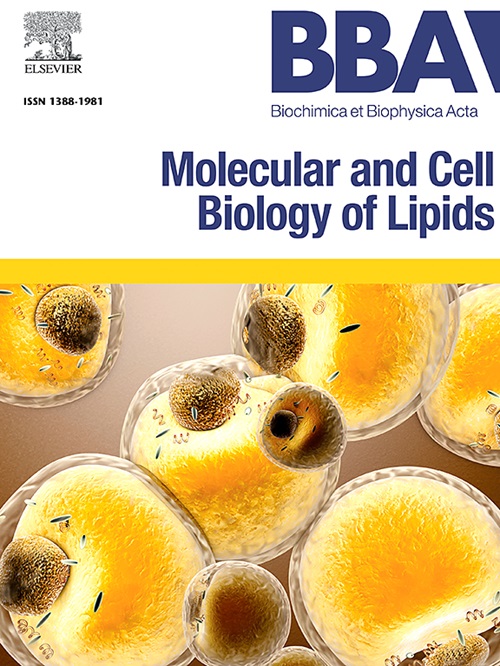The influence of IMPDH activity on ciliogenesis and adipogenesis of 3T3-L1 cells while undergoing differentiation
IF 3.3
2区 生物学
Q2 BIOCHEMISTRY & MOLECULAR BIOLOGY
Biochimica et biophysica acta. Molecular and cell biology of lipids
Pub Date : 2025-02-15
DOI:10.1016/j.bbalip.2025.159603
引用次数: 0
Abstract
The functional roles of primary cilia and inosine 5′-monophosphate dehydrogenase (IMPDH) are among the hot topics in today's adipogenesis research. Considering the reported interaction between IMPDH and ADP Ribosylation Factor-Like GTPase 13B (ARL13B), as a key ciliary protein, our study focused on this interaction during the ciliogenesis process while 3T3-L1 pre-adipocytes undergoing differentiation to lipid-accumulating adipocytes. Our results indicated that, in the early days of differentiation, when cilium length is long, IMPDH expression is high and its interaction with ARL13B is low. Conversely, in the last days of differentiation, the cilia length and IMPDH expression reduced while, the IMPDH/ARL13B interaction remains high relative to the initial days. In either of these two situations, IMPDH was not documented within the cilia. The extent of the interaction between IMPDH and ARL13B might account for the lack of co-localization of IMPDH and ARL13B within cilia during the process of differentiation. Although, inhibiting IMPDH in the early days of differentiation did not have a significant effect on cilia length, it did reduce adipogenesis by limiting mitotic clonal expansion through arresting cells in the G1/G0 phase. These findings provide the ground for further research to investigate the relationship between the IMPDH/ARL13B interaction and cilia length, which decline in obesity.
IMPDH活性对3T3-L1细胞分化过程中纤毛形成和脂肪形成的影响。
初级纤毛和肌苷5′-单磷酸脱氢酶(IMPDH)的功能作用是当今脂肪形成研究的热点之一。考虑到已报道的作为关键纤毛蛋白的IMPDH与ADP核糖基化因子样GTPase 13B (ARL13B)之间的相互作用,我们的研究重点关注了3 T3-L1前脂肪细胞向脂质积累脂肪细胞分化过程中纤毛发生过程中的相互作用。我们的研究结果表明,在分化早期,纤毛长度较长时,IMPDH表达量高,与ARL13B的相互作用低。相反,在分化的最后几天,纤毛长度和IMPDH表达减少,而IMPDH/ARL13B相互作用相对于分化初期保持较高水平。在这两种情况下,纤毛内没有记录IMPDH。IMPDH和ARL13B相互作用的程度可能解释了在分化过程中,IMPDH和ARL13B在纤毛内缺乏共定位的原因。虽然在分化早期抑制IMPDH对纤毛长度没有显著影响,但在G1/G0期阻滞细胞,通过限制有丝分裂克隆扩增,确实减少了脂肪形成。这些发现为进一步研究IMPDH/ARL13B相互作用与纤毛长度之间的关系提供了基础,纤毛长度在肥胖中下降。
本文章由计算机程序翻译,如有差异,请以英文原文为准。
求助全文
约1分钟内获得全文
求助全文
来源期刊
CiteScore
11.00
自引率
2.10%
发文量
109
审稿时长
53 days
期刊介绍:
BBA Molecular and Cell Biology of Lipids publishes papers on original research dealing with novel aspects of molecular genetics related to the lipidome, the biosynthesis of lipids, the role of lipids in cells and whole organisms, the regulation of lipid metabolism and function, and lipidomics in all organisms. Manuscripts should significantly advance the understanding of the molecular mechanisms underlying biological processes in which lipids are involved. Papers detailing novel methodology must report significant biochemical, molecular, or functional insight in the area of lipids.

 求助内容:
求助内容: 应助结果提醒方式:
应助结果提醒方式:


